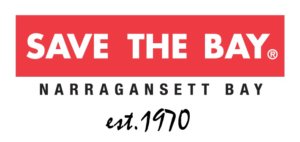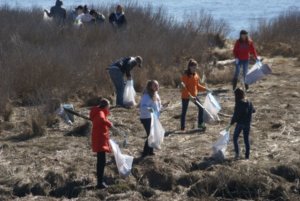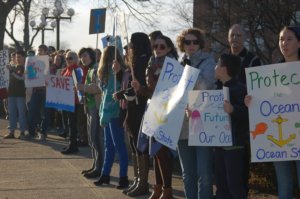- What is the mission and vision of Save The Bay?
Save The Bay’s mission is to protect and improve Narragansett Bay. Our vision is a fully swimmable, fishable, healthy Narragansett Bay accessible to all. We work to achieve our mission through environmental advocacy, habitat restoration and education programs and partnerships, all made possible by the support of our members, donors, partners, 4,000+ volunteers and interns, and countless community members who rise to the occasion when our Bay is under threat.
- How has Save The Bay’s mission and vision changed since its founding?
In concept, our mission and vision have remained constant for nearly 50 years, but our priorities and tactics have changed over the decades just as threats to our Bay and the community climate around environmental issues has changed. Save The Bay got its start in 1970, when a group of citizens came together to oppose (successfully) an oil refinery proposed in Tiverton. In our first decades, we were very much a fierce, vocal grassroots organization, drawing attention to blatant and unabashed pollution and threats such as raw sewage being dumped into our waters. As the big pollution issues of the 70s and 80s were addressed, we expanded our work to include restoration efforts—to help our marine ecosystems and coastal habitats rebound from all of that—and education programs to inspire the next generation of Bay stewards who will care for the Bay for the next 50 years. Our advocacy work continues, of course, and today requires strong and thoughtful collaboration with many partners and often over many years to battle the much more complex pollution threats today.
- What is one program or service that Save The Bay offers to the community that you wish more people knew about?
Our Exploration Center and Aquarium in Newport is definitely one of Rhode Island’s best-kept secrets. This sweet, small, hands-on marine science center, which is open year-round, is the perfect way to spend and hour or two with the kids, and for people of any age to get acquainted with the critters that live in Narragansett Bay. Adults and kids alike just love it, once they walk through our doors. The $8 admission price helps support the aquarium as well as Save The Bay’s advocacy and education work.
I also wish more people realized that Save The Bay is member supported and that our power and strength as their watchdog for Narragansett Bay and all of our local waters lies in the strength and growth of our membership, which currently stands at about 4,500 members. Narragansett Bay is enjoyed, one way or another, by all of Rhode Island and much of southeastern Massachusetts, and it’s the reason for Rhode Island’s strong marine economy. I’d like to see our membership reflect all who love and enjoy Narragansett Bay, so that we can continue to fight for clean, healthy, swimmable and fishable waters for the next 50 years, so our children, grandchildren and the next generations can enjoy the Bay as we do.
- What are the greatest current threats to the health of Narragansett Bay? And what are the greatest opportunities for improving the health of the Bay?
Great question! Of course, quick-response types of threats will always arise unexpectedly, such as the proposal two years ago to fill in a significant chunk of the Providence River or a threat to public access. But the “big three” ongoing and growing threats to Narragansett Bay today are: changing climate conditions, population pressures, and constrained government.
If you’ll allow me to elaborate briefly: Population pressures such as relentless suburban sprawl, coastal development and land use changes bring profound threats of polluted runoff and increased flooding. Climate change is bringing to this area more precipitation, more frequent and intense storms, and rising water temperatures and sea levels. Together, these effects are causing loss of our salt marshes and native species, degraded water conditions from polluted runoff, significant erosion, lower oxygen levels in the water to support marine life, harmful algal blooms, and flooding. And, finally, state and federal government agencies empowered to protect the Bay are increasingly starved of resources and deprived of political support necessary to enforce environmental laws.
A big opportunity for improving the health of the Bay lies in our ability to reduce polluted runoff—as individuals through our personal choices and behaviors, and collectively, when all those individual efforts work together toward a strong, meaningful impact. Polluted runoff occurs when rainwater flows from our roofs, driveways, streets and sidewalks, picks up such pollutants as chemicals, fertilizers, pet waste, oils, and road salt, and carries those with it into storm drains and waterways. Everything flows to the Bay eventually. Polluted runoff is one of the most significant contributors to pollution in Narragansett Bay and its entire watershed today.
But the great news is that it’s a problem we can do something about, if we would all just make a commitment. We can reduce the runoff itself—the water going down the drains— just by pointing our downspouts into our lawn or planted gardens, by collecting rainwater in rain barrels and reusing that, instead of sprinklers, to water our lawns and waters, by planting rain gardens that absorb water and native species that are already adapted to our natural climate, and by making driveways and patios out of porous surfaces rather than asphalt or concrete. We can reduce the pollutants that get into the runoff just as easily. Don’t use lawn chemicals, pick up pet waste, don’t litter or sweep road salt into the storm drain, and eliminate the need for fertilizer by watering less, keeping grass a little longer, and leaving grass clippings on the ground, and embracing clover, which provides natural nutrients to your lawn. By working together, we can all make a BIG difference. We have a great little guide called Bay-Friendly Living that offers lawn care and lifestyle tips that can save people money and time while also helping to save the Bay. People can download it from savebay.org/bayfriendlyliving or call us for a printed copy.
- Tell us more about your Education Department. How does Save The Bay teach children, teens, and adults alike how to be stewards of Rhode Island’s greatest natural resource?
The goal of our education program is to inspire the next generation of Bay stewards. If Narragansett Bay is to remain the incredible resource it is today for generations to come, we must teach young people today about its value to this region’s beauty, economy, way of life and quality of life. We must instill in them a sense of ownership and responsibility for the Bay.
We’ve developed a robust curriculum of hands-on marine science and environmental education courses and programs that get students out onto the Bay, along our shorelines, into our aquarium, and into our classrooms at the Bay Center. We serve about 15,000 K-12 and college students every year. Many adults today remember coming to Save The Bay for a field trip in elementary school, and we still do one-time field trips. But now we frequently partner with schools and school districts to integrate our curriculum into their science curriculum or afterschool programs for many high-quality programs throughout the school year. In fact, 14 hours is the average time a K-12 student spends with us in any given year. Our courses fulfill several national science standards, so it’s very much a win-win for teachers and students.
- Tell us more about the innovative Save The Bay Center. Can the public visit?
When we opened our Bay Center in 2005, we envisioned an education space for our students and a community resource that could connect Providence urban communities with the Bay. Inside, the Bay Center offers our students two classrooms with aquariums, touch tanks and plankton lab. Outside, students do habitat exploration along our rocky shoreline, salt marsh and coastal buffer, and there’s an outdoor amphitheatre. We take students out on the water in our education vessels from the dock on our grounds. And our building itself is a living classroom, with a number of energy efficient features. One side of the roof is planted with vegetation that acts as insulation and reduces stormwater runoff. Solar panels on the other side of the roof provide renewable energy and reduce our carbon footprint. Ambient lighting allows us to minimize our energy usage. Trenches and swales on our grounds prevent flooding and filter runoff. And the site itself was once a landfilll, which we cleaned up in order to create a beautiful place with public access to the waterfront. Our grounds, part of Providence’s Urban Coastal Greenway, are open to the public from dawn to dusk, and any given time you can see dozens of local folks walking the trail and fishing and kayaking along the shoreline. We will soon enhance public access with a public pier to support boating, fishing and kayaking.
- How can our community get involved in the work of Save The Bay?
Our work is made possible by the support of thousands of volunteers who work with us in every capacity every year – from office help to habitat restoration help. One of the best and easiest ways to get involved is to volunteer for a beach cleanup. We do beach cleanups from spring through late fall, all over the state, so community members have many options for a cleanup that fits their schedule and is near them. Beach cleanups are exactly what the sound like—volunteers head out to our beaches and shoreline with trash bags and gloves and pick up litter. They typically last an hour or two. It’s a perfect way to get outside, enjoy the beauty of Rhode Island’s shoreline, and do something great for the environment. People interested in volunteering can check our our volunteer opportunities at savebay.org/volunteer
- Are there any upcoming events or activities you would like to share with us?
We have several great events and opportunities get involved with Save The Bay every year. Coming up in June, Taste of the Bay is a great foodie-friendly fundraising event right on our Bayfront back yard that celebrates the flavors of Narragansett Bay. In the summer, our iconic Save The Bay swim engages tons of volunteers and spectators and celebrates the cleanup of Narragansett Bay over the last nearly 50 years. In September, thousands of volunteers come out for our International Coastal Cleanup, picking up trash almost 100 sites all over Rhode Island. Our Artists for the Bay Show and Sale in December highlights the work of dozens of local artists, artisans and jewelers who sell their work to benefit Save The Bay.
We also have several wonderful public programs that give people the chance to get up close and personal with Narragansett Bay. We have seal tours on the Bay from October through April, Lighthouse Tours in June through October, summer BayCamps for K-12 kids, and our hands-on Exploration Center and Aquarium in Newport is open year-round.
- Where can we go to learn more: Folks can always visit our website at savebay.org, Twitter @SaveTheBayRI, or call us at 272-3540.
Click here to add your own text





